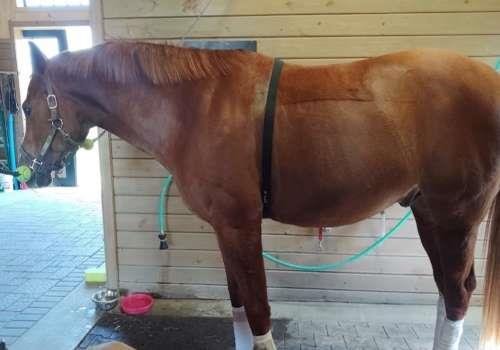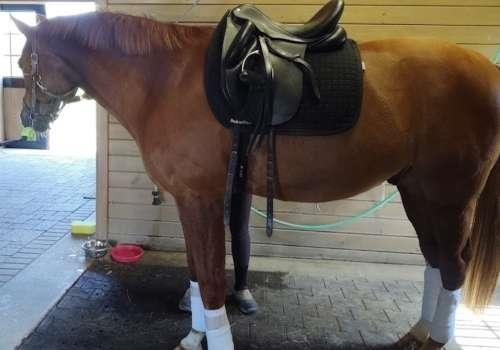By Danielle Smarsh
Accurately characterizing a horse's workload is important for balancing their diet and maintaining horse health.
The ability to accurately characterize a horse's workload is an important part of management. This allows caretakers to provide enough calories and nutrients to ensure proper body weight and condition in their horses.
Just like humans, horses require energy to power their muscles for movement. Energy is present in all feed; for horses, this includes grain, hay, and fresh pasture. Feeds with high amounts of fat, starch, and sugar provide the most energy. However, unlike humans, the horse’s digestive system also allows it to use a large amount of fiber for energy. Through metabolism, the energy in the feed consumed is converted to energy that can be used for movement. For this to occur, horses will need to be supplied with a certain amount of energy in their diet each day.
So how much energy is needed for horses that exercise? What about horses that are in intense or very heavy exercise compared to horses in light exercise? The National Research Council (NRC) has answered these questions based on previous equine research. The NRC published The Nutrient Requirements of The Horse (2007), which compiles research data and splits exercise workload into four categories (Table 1) which are then used to determine a horse’s energy needs.
| Exercise Category | Average Heart Rate | Exercise Description | Types of Events |
| Light | 80 beats per minute | 1-3 hours per week; 40% walk, 50% trot, 10% canter | Recreational riding Beginning of training programs Show horses (occasional) |
| Moderate | 90 beats per minute | 3-5 hours per week; 30% walk, 55% trot, 10% canter, 5% low jumping, cutting or other skill work | School horses Recreational riding Beginning of training/ breaking Show horses (frequent) Polo Ranch work |
| Heavy | 110 beats per minute | 4-5 hours per week; 20% walk, 50% trot, 15% canter, 15 % gallop, jumping, other skill work | Ranch work Polo Show horses (frequent, strenuous events) Low-medium level eventing Race training (middle stages) |
| Very Heavy | 110-115 beats per minute | Varies; ranges from 1 hour per week speed work to 6-12 hours per week slow work | Racing (Quarter horse, Thoroughbred, Standardbred, endurance) Elite 3-day event |
Table 1 National Research Council- Nutritional Requirements of the Horse (2007)
Duration, Frequency, and Intensity of Exercise
When characterizing a horse’s workload, caretakers need to think about the duration (time spent exercising per week), frequency (how often a horse is exercised per week), and intensity of exercise. The intensity of exercise refers to how hard the horse is working. This can be identified by the time spent at each gait. A horse that gallops for a certain amount of time will expend more energy compared to a horse that walks for the same duration of time; therefore, the exercise would be a higher intensity. Intensity can also be estimated by the horse’s average heart rate.
It has been found that there is a relationship between the horse's heart rate and its oxygen uptake. The horse’s oxygen uptake refers to the amount of oxygen inhaled by the horse that will then be used to fuel metabolism within their skeletal muscles during exercise. Estimating the oxygen uptake helps researchers estimate how much energy is being expended by the horse during exercise. However, the average person cannot measure how much oxygen is being used by their horse. Observing the horse's heart rate is a more user-friendly way to estimate how much oxygen is being utilized, and thus how much energy is being expended during exercise. As the heart rate increases, more oxygen will be used by the horse to fuel their movement during exercise. The heart rate can be accurately measured using an equine heart rate monitor (Figure 1, 2).

Figure 1. Horse wearing an equine heart rate monitor prior to being tacked up.

Figure 2. Horse wearing an equine heart rate monitor under tack.
Measuring the horse’s pulse by hand is not an accurate way to determine the horse’s heart rate during exercise. By the time a horse comes to a stop and the rider dismounts to check the pulse, the horse’s heart rate has already drastically decreased. Using an equine heart rate monitor can track the horse’s heart rate over the entire exercise session and provide an opportunity to calculate the average heart rate. The NRC table provides some general heart rate averages that may be found for each exercise level. The use of an equine heart rate monitor in addition to identifying the frequency and duration of exercise may help to properly estimate a horse’s workload.
Once you have determined the duration, frequency, and intensity within a horse’s exercise routine, you can use the table created by the NRC to determine if your horse fits into the light, moderate, heavy or very heavy exercise category. This table can direct you in determining your horse’s energy needs and how you may need to make nutritional adjustments to meet these requirements.
Exercise Requires Energy
For each exercise level, the 2007 NRC also provides daily energy requirements. To provide some reference, an adult 1,000-pound horse at an average maintenance level (meaning the horse is not in work, pregnant, lactating, or breeding) requires about 17 megacalories (Mcal)/day. Horses within the different exercise categories would then need a certain percent increase in energy being supplied per day through their diet.
- Light Exercise: 20% increase above the daily digestible energy maintenance requirement
- Moderate Exercise: 40% increase above the daily digestible energy maintenance requirement
- Heavy Exercise: 60% increase above the daily digestible energy maintenance requirement
- Very Heavy Exercise: 90% increase above the daily digestible energy maintenance requirement
However, it is important to note that there is a lot of individual variation in horses, and a horse may need less or more DE per day. For example, a horse may tend to put on weight more easily due to breed and genetic predisposition, and therefore will need less energy than the NRC requirement to maintain a good body condition. Ponies are an excellent example of equids that tend to be "easy-keepers" and gain weight from very little feed. On the opposite end of the spectrum, some horses may be harder to keep weight on due to breed or temperament and may need more energy than their NRC energy requirements to maintain a good body condition, such as Thoroughbreds. In addition, feed tags usually don’t provide energy content, so it can be hard to know exactly how much energy you are feeding. This is why it is important to monitor each horse’s individual body weight and condition and adjust the diet as needed.
Conclusion
Overall, providing the accurate amount of energy to a horse per day requires knowledge of the average daily requirement and how this energy requirement changes based on the exercise workload. Furthermore, providing the accurate amount of energy per day will also require caretakers to observe their horses and keep track of their weight or their body condition score. If a horse is in exercise but is beginning to lose weight/condition, then more energy may need to be supplied in the diet. For example, you could top dress the horse’s feed with oil or choose a feed that has a high fat percentage. More information on energy sources for horses can be found in this article. If a horse is in exercise but is still gaining weight/condition, then either the diet, exercise schedule, or both need to be adjusted. Working with an equine nutritionist can help caretakers formulate a diet with the appropriate amount of energy for their horse while balancing other essential nutrients.
Source : psu.edu